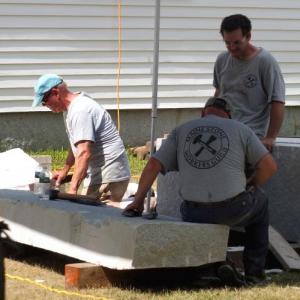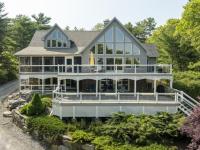Maine Stone Workers Guild Weekend rocks visitors
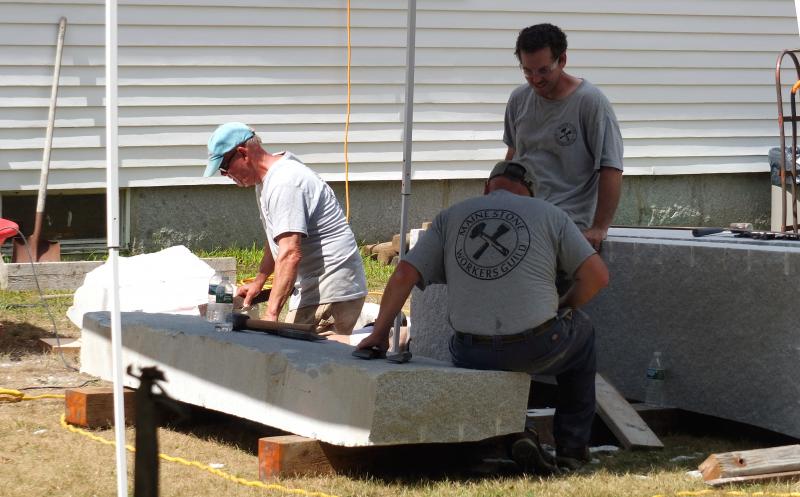 Three members of the Maine Stone Workers Guild Aug. 15 chisel out one of the steps for Boothbay Railway Village’s Town Hall. LISA KRISTOFF/Boothbay Register
Three members of the Maine Stone Workers Guild Aug. 15 chisel out one of the steps for Boothbay Railway Village’s Town Hall. LISA KRISTOFF/Boothbay Register
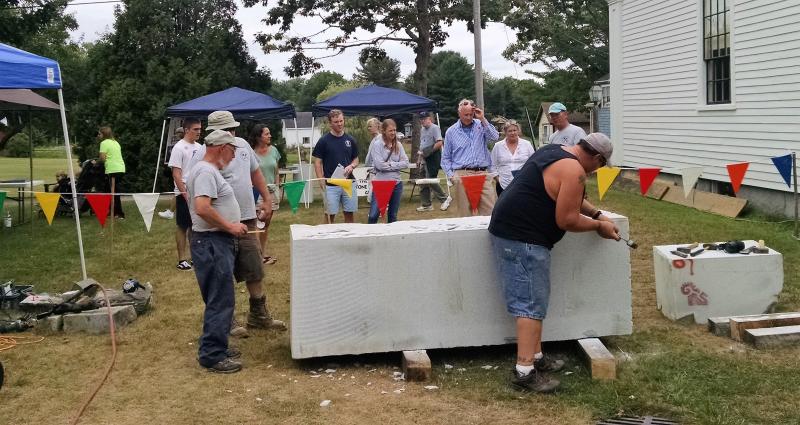 A crowd gathers on Aug. 14 to watch the Maine Stone Workers Guild in action at Boothbay Railway Village Museum. Margaret Hoffman photo
A crowd gathers on Aug. 14 to watch the Maine Stone Workers Guild in action at Boothbay Railway Village Museum. Margaret Hoffman photo
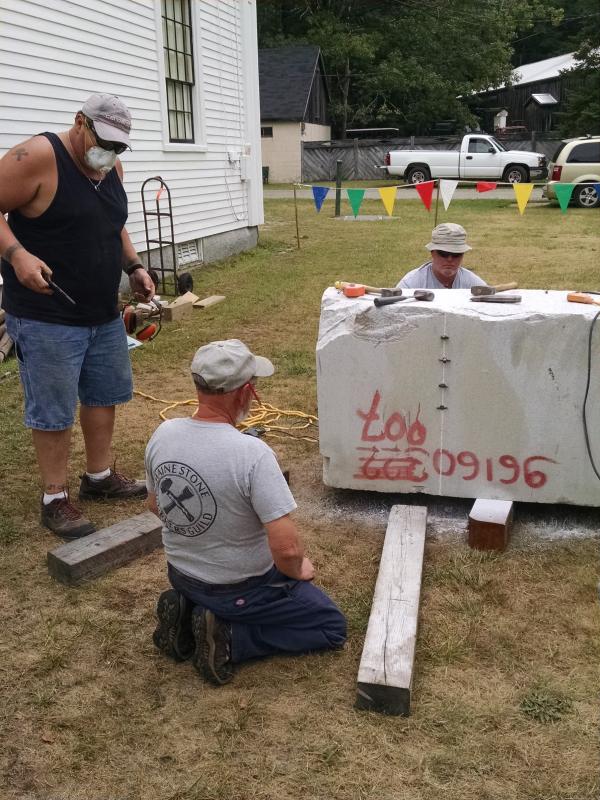 Preparing to make the first cut off the ends of the four and a half- ton block of North Jay white granite Aug. 14 at Boothbay Railway Village Museum. Margaret Hoffman photo
Preparing to make the first cut off the ends of the four and a half- ton block of North Jay white granite Aug. 14 at Boothbay Railway Village Museum. Margaret Hoffman photo
 Three members of the Maine Stone Workers Guild Aug. 15 chisel out one of the steps for Boothbay Railway Village’s Town Hall. LISA KRISTOFF/Boothbay Register
Three members of the Maine Stone Workers Guild Aug. 15 chisel out one of the steps for Boothbay Railway Village’s Town Hall. LISA KRISTOFF/Boothbay Register
 A crowd gathers on Aug. 14 to watch the Maine Stone Workers Guild in action at Boothbay Railway Village Museum. Margaret Hoffman photo
A crowd gathers on Aug. 14 to watch the Maine Stone Workers Guild in action at Boothbay Railway Village Museum. Margaret Hoffman photo
 Preparing to make the first cut off the ends of the four and a half- ton block of North Jay white granite Aug. 14 at Boothbay Railway Village Museum. Margaret Hoffman photo
Preparing to make the first cut off the ends of the four and a half- ton block of North Jay white granite Aug. 14 at Boothbay Railway Village Museum. Margaret Hoffman photo
A 9,000-pound piece of North Jay white granite was transported to the Boothbay Railway Village Museum by J.C. Stone on Aug. 13. North Jay is J.C.'s “signature stone” used in historic restoration projects. And that's just what members of the Maine Stone Workers Guild (MSWG) were using it for: to replace the pressure-treated wood stairs of the Musuem's 1847 Town Hall.
The idea materialized during a brainstorming session between MSWG Treasurer (and East Boothbay stone sculptor) Dick Alden and the Museum's Executive Director Margaret Hoffman. The two were developing a new event for the Route 27 attraction: the Maine Coast Stone Symposium. A month-long celebration of the state's stone industry — its history, role in culture and as an art form — will include a 10-day sculpture symposium. Alden expects about 12 sculptors to participate in this live demonstration of this ages old craft. Hoffman and Alden ultimately decided that the Town Hall stairs would be the perfect prelude to the major 2017 event and a way to scope out public interest. For more on the 2017 event, visit http://railwayvillage.org.
Back to the project. On Aug. 14 the largest number of Guild members were on the scene to receive the granite slab donated by J.C. Stone and begin work: Norman Casas, Guild founder of Washington, David Curry from Union, Richard Bois of Wells, Alden of East Boothbay, Gibran and Obadiah Buell from Sullivan; and Jon Doody (Augusta), came in the early afternoon.
The Guild members first split off the ends of the four and a half-ton block. Then they split it in the center before splitting it one more time. They left themselves one block to use as backup — just in case. The backup piece was used to lay out the tools. The new steps are 84" long with 7 1/2" risers. Alden said the top step is about 20"- 22" and the bottom 16-17" wide. Fortunately the backup piece wasn't needed. Alden said it would most likely be saved for the 2017 event.
Casas, who owns the Washington Monument Company, started cutting stone in the early 1970s. He says of the trade, “Once you get started you can't stop.”
Different chisels were used during the process. The tops of the chisels, called striking caps, are hit at different angles and areas by a hammer. In this case, similar to billiard players putting English on a ball. Casas explained stone workers used different tools for different results; the hand set has two sharp edges on it to drive down deeply into the stone. It’s all about understanding stone.
“The stone does the talking,” Casas said. “You can't fool Mother Nature, she will do what she will do. All we can do is guide. And suggest. And encourage. That's what we do — we give the stone encouragement.”
Curry, a stonemason who recently moved into sculpture, has worked with stone for 10 years and has been a Guild member the last four to five years. He said, “You know when you're about to get in trouble when you hear “T-T-T-ONG!” Everyone laughs, all too familiar with this not-what-you-want-to-hear “stone speak!”
Guild member Doody wasn't there working on the steps. He was demonstrating the strictly artistic side of stone work for the first time in a public presentation. Doody is a traditional and folk artist working with reclaimed and leftover stone. For 10 years he carved wood and then a friend suggested he try stone. That was two years ago. Doody had two projects going. One a black slate hearthstone that was unfinished from a friend’s woodstove area that he had polished finely. The other was a Celtic symbol he was carving into a piece of marble. “I’ve had great response from the people, who have had lots of questions,” Doody said. He is seriously thinking about being part of the 2017 event.
The Guild attracted the attention of many a museum visitor over the weekend as they talked to the granite. The plan was to install the steps on Sunday the 15th, but due to the weather and having to move the 9,000-pound block twice (once from the original drop off location behind the area the Guild had erected as shelter from the blistering sun, with Eric Wood’s boom truck; and then the block had to be turned around in place — by just Alden and Casas — to have the grain in the right direction), the steps will be installed with the assistance of a boom truck later this week.
Hoffman says holding events such as the weekend with the Maine Stone Workers Guild and next year's month-long symposium at the Museum “help capture the magic of this traditional craft.”
“A stone sculpture symposium might seem like a departure for the Museum. In reality, stone work has been an important industry in Maine for more than 200 hundred years,” said Hoffman. “The sculpture created now is built upon the foundation laid by generations of quarrymen, stone cutters, masons and carvers.” In 2017, there will be talks by quarriers, landscapers, builders and sculptors and a week of demonstrations of stone splitting and sculpture.
The weekend event and next year’s Maine Coast Stone Symposium fulfill a facet of the Museum’s mission: to make history relevant to people.
For more on the Maine Stone Workers Guild, visit http://mainestoneworkersguild.org.
Event Date
Address
United States

